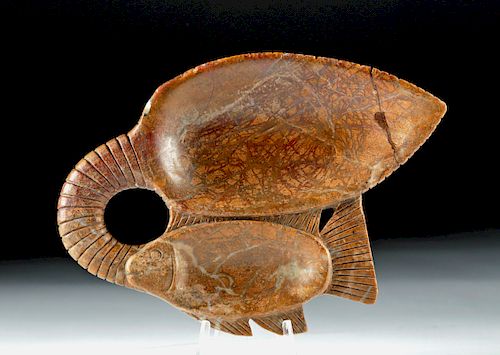Egyptian Steatite Cosmetic Dish - Double Fish
Lot 2a
About Seller
Artemis Fine Arts
686 S Taylor Ave, Ste 106
Louisville, CO 80027
United States
Selling antiquities, ancient and ethnographic art online since 1993, Artemis Gallery specializes in Classical Antiquities (Egyptian, Greek, Roman, Near Eastern), Asian, Pre-Columbian, African / Tribal / Oceanographic art. Our extensive inventory includes pottery, stone, metal, wood, glass and textil...Read more
Estimate:
$3,500 - $5,000
Absentee vs Live bid
Two ways to bid:
- Leave a max absentee bid and the platform will bid on your behalf up to your maximum bid during the live auction.
- Bid live during the auction and your bids will be submitted real-time to the auctioneer.
Bid Increments
| Price | Bid Increment |
|---|---|
| $0 | $25 |
| $300 | $50 |
| $1,000 | $100 |
| $2,000 | $250 |
| $5,000 | $500 |
| $10,000 | $1,000 |
| $20,000 | $2,500 |
| $50,000 | $5,000 |
| $100,000 | $10,000 |
| $200,000 | $20,000 |
About Auction
By Artemis Fine Arts
Feb 21, 2019
Set Reminder
2019-02-21 10:00:00
2019-02-21 10:00:00
America/New_York
Bidsquare
Bidsquare : Exceptional Antiquities, Asian, Ethnographic
https://www.bidsquare.com/auctions/artemis-gallery/exceptional-antiquities-asian-ethnographic-3858
An important one-day auction featuring museum-worthy examples of Egyptian, Greek, Roman, Etruscan, Near Eastern, Far East / Asian, Pre-Columbian, African / Tribal, Oceanic, Native American, Spanish Colonial, Russian, Fossils, Ancient Jewelry, Fine Art, so much more! Artemis Fine Arts info@artemisgallery.com
An important one-day auction featuring museum-worthy examples of Egyptian, Greek, Roman, Etruscan, Near Eastern, Far East / Asian, Pre-Columbian, African / Tribal, Oceanic, Native American, Spanish Colonial, Russian, Fossils, Ancient Jewelry, Fine Art, so much more! Artemis Fine Arts info@artemisgallery.com
- Lot Description
Ancient Egypt, New Kingdom / Third Intermediate Period, ca. 1550 to 712 BCE. A handsome steatite cosmetic dish in the form of a fish, a remarkably long-lived style of dish favored by the ancient Egyptians. The stone it is carved from is a beautiful mottled dark and light brown with a hint of red from iron content; thin, almost translucent ivory-colored bands pass across the face of the vessel. Unusually, this example has two dishes - a smaller one in the form of a Bolti fish (Nile tilapia), with the distinctive gills and lower fins of that species, and a larger in a more abstract fish-body or leaf-form. They are joined by a curved piece of stone that mirrors the incised form of the fish's fins. Size: 3.95" L x 5.55" W x 0.7" H (10 cm x 14.1 cm x 1.8 cm)
This type of vessel was used to hold cosmetics - the Egyptians are famous for the cosmetics worn by both men and women, like black kohl painted around the eyes. Fish were an important motif in ancient Egypt, and we even have evidence of mummified fish (you can see one in the Louvre!). The tilapia - known as the bolti fish or the nekhau - symbolized regeneration to the ancient Egyptians.
See an example made from a similar material at the Metropolitan Museum of Art: https://www.metmuseum.org/art/collection/search/547764
Provenance: private East Coast, USA collection; ex-Dr. Sid Port collection, California, USA, acquired in the 1970s
All items legal to buy/sell under U.S. Statute covering cultural patrimony Code 2600, CHAPTER 14, and are guaranteed to be as described or your money back.
A Certificate of Authenticity will accompany all winning bids.
We ship worldwide and handle all shipping in-house for your convenience.
#143609Tip of larger dish has been repaired. A few tiny chips from the rim; otherwise in very good condition with a nice smooth surface and finely preserved carving.Condition
- Shipping Info
-
All shipping is handled in-house for your convenience. Your invoice from Artemis Gallery will include shipping calculation instructions. If in doubt, please inquire BEFORE bidding for estimated shipping costs for individual items.
-
- Buyer's Premium



 EUR
EUR CAD
CAD AUD
AUD GBP
GBP MXN
MXN HKD
HKD CNY
CNY MYR
MYR SEK
SEK SGD
SGD CHF
CHF THB
THB














